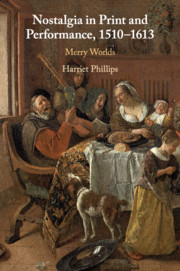Refine search
Actions for selected content:
6 results
10 - Play
-
- Book:
- Feeling, Thinking, and Talking
- Published online:
- 08 September 2022
- Print publication:
- 15 September 2022, pp 207-222
-
- Chapter
- Export citation
Chapter 6 - Shakespeare’s Ballads, 1598–1610
-
- Book:
- Nostalgia in Print and Performance, 1510–1613
- Published online:
- 08 June 2019
- Print publication:
- 27 June 2019, pp 156-178
-
- Chapter
- Export citation
Chapter 1 - Merry Worlds
-
- Book:
- Nostalgia in Print and Performance, 1510–1613
- Published online:
- 08 June 2019
- Print publication:
- 27 June 2019, pp 31-59
-
- Chapter
- Export citation
Chapter 7 - The Merry Worlds of Windsor in 1600
-
- Book:
- Nostalgia in Print and Performance, 1510–1613
- Published online:
- 08 June 2019
- Print publication:
- 27 June 2019, pp 179-205
-
- Chapter
- Export citation
Chapter 5 - Merry Histories, 1598–1599
-
- Book:
- Nostalgia in Print and Performance, 1510–1613
- Published online:
- 08 June 2019
- Print publication:
- 27 June 2019, pp 131-155
-
- Chapter
- Export citation

Nostalgia in Print and Performance, 1510–1613
- Merry Worlds
-
- Published online:
- 08 June 2019
- Print publication:
- 27 June 2019
